Finding the right pricing strategy is crucial for indie game developers aiming to maximize revenue and reach diverse audiences. This article explores various pricing models, including premium, freemium, and subscription options, while examining market trends and production costs. It also highlights the psychological factors influencing consumer behavior and offers best practices for effective pricing strategies. Additionally, the impact of regional pricing differences and innovative approaches like “pay-what-you-want” will be discussed.
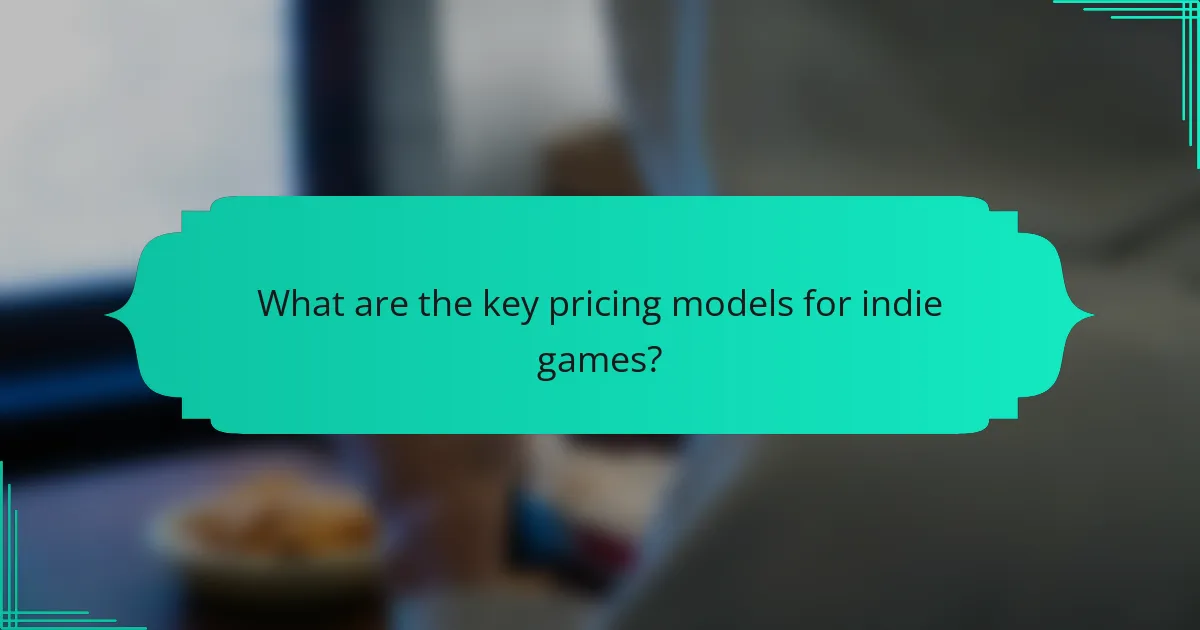
What are the key pricing models for indie games?
Indie games utilize various pricing models to maximize revenue and reach audiences. Key pricing strategies include premium pricing, where games are sold at a fixed price; freemium models, offering free access with in-game purchases; and subscription services, providing access to multiple games for a recurring fee. Each model has unique attributes affecting market penetration and player engagement. For instance, premium pricing often appeals to dedicated gamers seeking quality, while freemium models attract a broader audience by lowering the entry barrier.
How do cost-plus pricing and value-based pricing differ?
Cost-plus pricing adds a markup to the production cost, while value-based pricing sets prices based on perceived customer value. Cost-plus pricing ensures coverage of expenses, whereas value-based pricing focuses on maximizing customer satisfaction and revenue potential. This distinction impacts revenue strategies for indie games, as aligning prices with player perceptions can enhance sales and loyalty.
What is dynamic pricing and how is it applied in the gaming industry?
Dynamic pricing adjusts game prices based on demand, competition, and player behavior. In the gaming industry, this strategy helps optimize revenue and attract diverse player segments. For instance, indie games may lower prices during sales to increase visibility and boost player engagement. This approach can enhance sales velocity while maintaining a competitive edge. Additionally, real-time data analytics enable developers to respond to market fluctuations, maximizing profitability.
How do subscription models impact indie game pricing?
Subscription models often lower upfront costs for indie games, impacting pricing strategies. These models provide steady revenue streams, allowing developers to experiment with pricing. Players may perceive subscription access as added value, encouraging engagement. Additionally, pricing flexibility can adapt to player feedback and market trends, optimizing profitability.
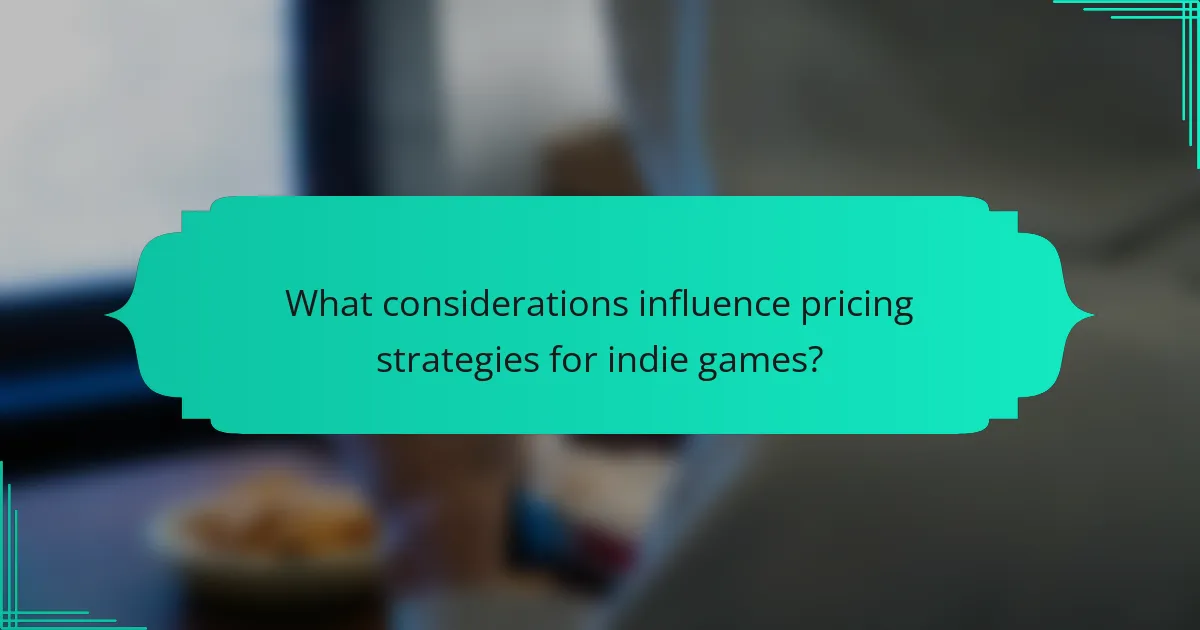
What considerations influence pricing strategies for indie games?
Pricing strategies for indie games are influenced by market trends, production costs, and target audience. Game developers must consider factors such as perceived value, competition, and distribution platforms. The pricing model chosen, whether premium, freemium, or subscription, plays a crucial role in revenue generation. Additionally, promotional strategies and community engagement can significantly impact sales performance.
How do market research and competitor analysis shape pricing decisions?
Market research and competitor analysis directly inform pricing decisions by providing insights into consumer preferences and market trends. These analyses help indie game developers identify optimal price points, ensuring competitiveness while maximizing revenue. Understanding competitors’ pricing strategies allows developers to position their games effectively, highlighting unique attributes that justify their pricing. Additionally, market research reveals player willingness to pay, guiding pricing models such as premium, freemium, or subscription-based approaches. Ultimately, informed pricing strategies can enhance market penetration and profitability.
What role does target audience play in pricing strategy formulation?
Target audience significantly influences pricing strategy formulation for indie games. Understanding the demographics, preferences, and spending habits of potential players helps determine optimal price points. For example, younger audiences may prefer lower prices due to limited budgets, while dedicated gamers might invest more for premium content. Tailoring prices to match audience expectations enhances sales and fosters loyalty. Additionally, market research reveals how similar games are priced, guiding indie developers in setting competitive rates. Engaging with the target audience through surveys or beta testing can yield valuable insights, refining pricing strategies further.
How do platform fees and distribution costs affect pricing?
Platform fees and distribution costs significantly impact indie game pricing by reducing profit margins. These expenses can range from 15% to 30% of sales, forcing developers to adjust their pricing strategies. Higher fees may lead to increased game prices, potentially deterring consumers. Conversely, lower fees allow for competitive pricing, enhancing market reach. Balancing these costs is crucial for sustaining profitability while appealing to gamers.
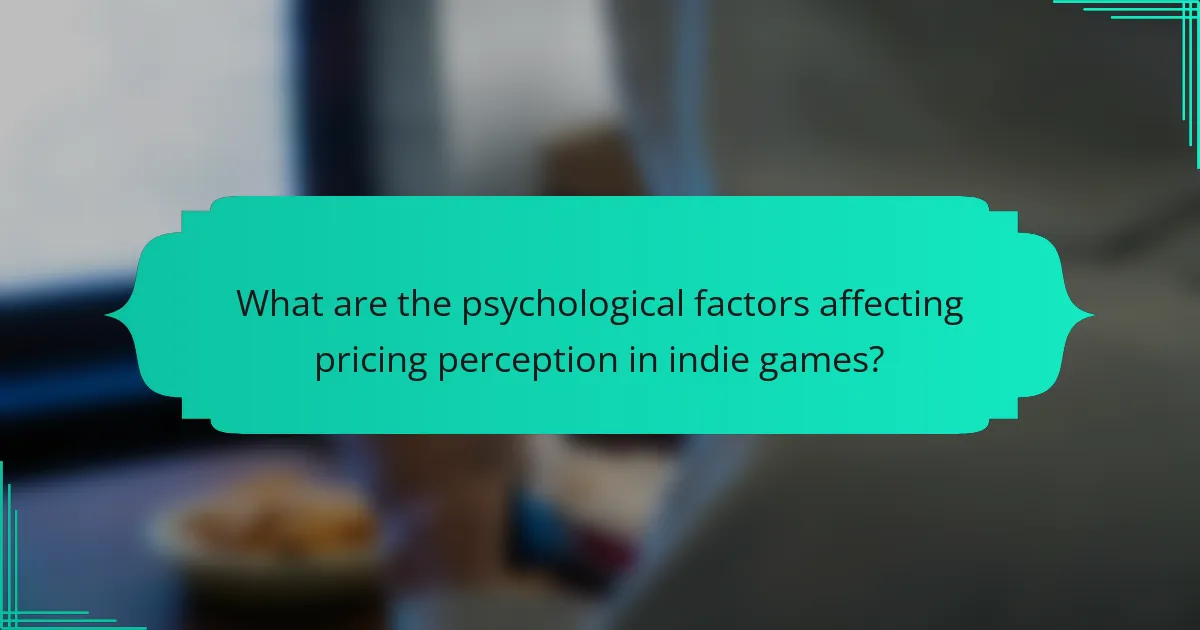
What are the psychological factors affecting pricing perception in indie games?
Psychological factors significantly influence pricing perception in indie games. Consumers often associate price with quality, leading to a perception that higher prices indicate superior gameplay experiences. The anchoring effect plays a critical role, as initial price points set expectations for value. Additionally, perceived scarcity can enhance desirability; limited-time offers or exclusive content can drive urgency. Social proof, such as reviews and ratings, further impacts how potential buyers assess value, often leading to a willingness to pay more for games with positive endorsements.
How does perceived value influence consumer buying behavior?
Perceived value significantly influences consumer buying behavior by affecting their willingness to pay. Indie game pricing strategies must consider how consumers perceive the quality and uniqueness of the product.
When consumers view an indie game as high-quality or innovative, they are more likely to accept higher prices. Factors such as visual design, gameplay mechanics, and narrative depth contribute to this perception.
Additionally, perceived value can create brand loyalty. Gamers who feel a strong connection to an indie game’s aesthetic or story may be inclined to purchase sequels or related merchandise.
Ultimately, understanding perceived value allows indie developers to set prices that align with consumer expectations, maximizing both sales and brand reputation.
What pricing tactics can create urgency and boost sales?
Urgency in pricing can significantly boost sales for indie games. Implementing limited-time offers, countdown timers, and exclusive discounts can create a sense of urgency. These tactics encourage immediate purchases, driving higher conversion rates. For example, a game priced at $19.99 might offer a 20% discount for the first week, motivating players to buy before the price rises. Additionally, highlighting scarcity, such as limited edition content, can further enhance urgency and appeal.

What are the potential impacts of pricing strategies on sales and revenue?
Pricing strategies significantly influence sales and revenue for indie games. Effective pricing can enhance visibility, attract players, and maximize profits.
Different models, such as premium, freemium, and subscription, impact consumer behavior uniquely. For instance, a freemium model may lead to a larger player base, while premium pricing can signal quality and exclusivity.
Considerations like market trends, competitor pricing, and perceived value shape strategy effectiveness. Analyzing player demographics and preferences can refine pricing approaches for better outcomes.
In summary, the right pricing strategy can optimize sales and revenue, ensuring sustainable growth for indie game developers.
How do pricing strategies affect customer retention and loyalty?
Pricing strategies significantly influence customer retention and loyalty by shaping perceived value and satisfaction. Competitive pricing can attract initial customers, while value-based pricing fosters long-term loyalty through perceived fairness and quality.
Indie games often employ various pricing models, such as pay-what-you-want, subscription, and tiered pricing. These models can create a sense of community and commitment among players, enhancing retention. Additionally, promotional pricing during key events can boost engagement and encourage repeat purchases.
Understanding customer preferences and behaviors is crucial in determining the right pricing strategy. Data analytics can reveal trends that inform pricing adjustments, ensuring alignment with customer expectations.
Ultimately, a well-crafted pricing strategy not only drives sales but also cultivates a loyal player base, essential for the sustainability of indie game developers.
What is the relationship between pricing and game reviews or ratings?
Pricing strategies significantly influence game reviews and ratings. Higher prices may lead to increased expectations, while lower prices can attract more players. As a result, pricing can directly impact perceived value and overall satisfaction. Indie games often face unique challenges; their pricing must balance affordability with quality perception. For instance, games priced too low may be viewed as inferior, while those priced too high risk alienating potential buyers. Thus, understanding this relationship is crucial for indie developers aiming to optimize their pricing models and enhance user feedback.
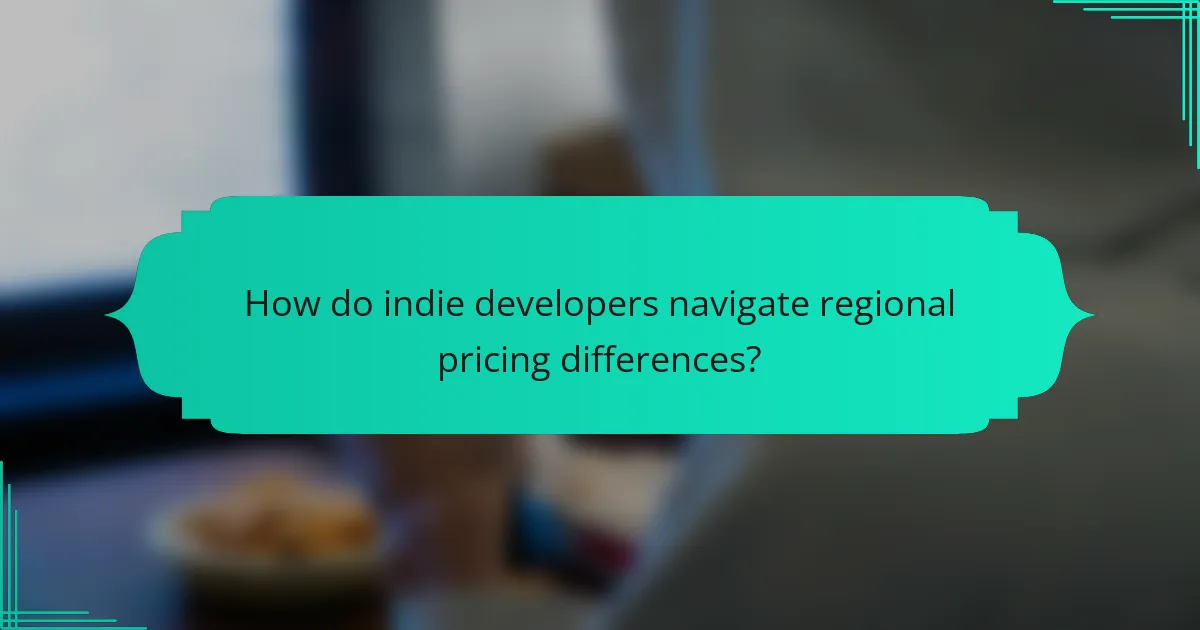
How do indie developers navigate regional pricing differences?
Indie developers navigate regional pricing differences by employing adaptive pricing strategies. They analyze local market conditions, purchasing power, and competitor pricing to set optimal prices.
Additionally, they often utilize tiered pricing models that cater to various regions. This approach allows them to maximize revenue while ensuring accessibility for players in different economic contexts.
Furthermore, gathering player feedback helps refine pricing strategies over time. By understanding player sentiments and preferences, developers can adjust their pricing to enhance sales and player satisfaction.
What challenges arise from currency fluctuations and local purchasing power?
Currency fluctuations and local purchasing power can significantly impact indie game pricing strategies. These challenges influence how developers set prices to remain competitive and profitable in different markets.
Fluctuating exchange rates can alter the perceived value of a game, prompting adjustments to pricing models. For example, a strong local currency may lead to higher prices, while a weak currency might necessitate lower prices to attract buyers.
Local purchasing power varies across regions, affecting consumers’ ability to afford games. Developers must consider average income levels and spending habits in specific markets. This understanding helps tailor pricing strategies that resonate with local audiences and maximize sales.
Incorporating localized pricing strategies can mitigate the effects of currency fluctuations and enhance market penetration. By analyzing regional economic conditions, indie developers can optimize their pricing to align with consumers’ financial capabilities.
How can cultural preferences shape pricing strategies in different markets?
Cultural preferences significantly influence pricing strategies for indie games in various markets. Understanding local values, spending habits, and entertainment preferences helps tailor pricing effectively.
For instance, in markets where gaming is viewed as a luxury, higher price points may be acceptable. Conversely, in regions where affordability is prioritized, competitive pricing or freemium models may be more effective.
Additionally, cultural attitudes towards digital content can affect willingness to pay. In some cultures, consumers may expect lower prices for digital goods compared to physical products.
Overall, aligning pricing strategies with cultural preferences enhances market penetration and consumer satisfaction.
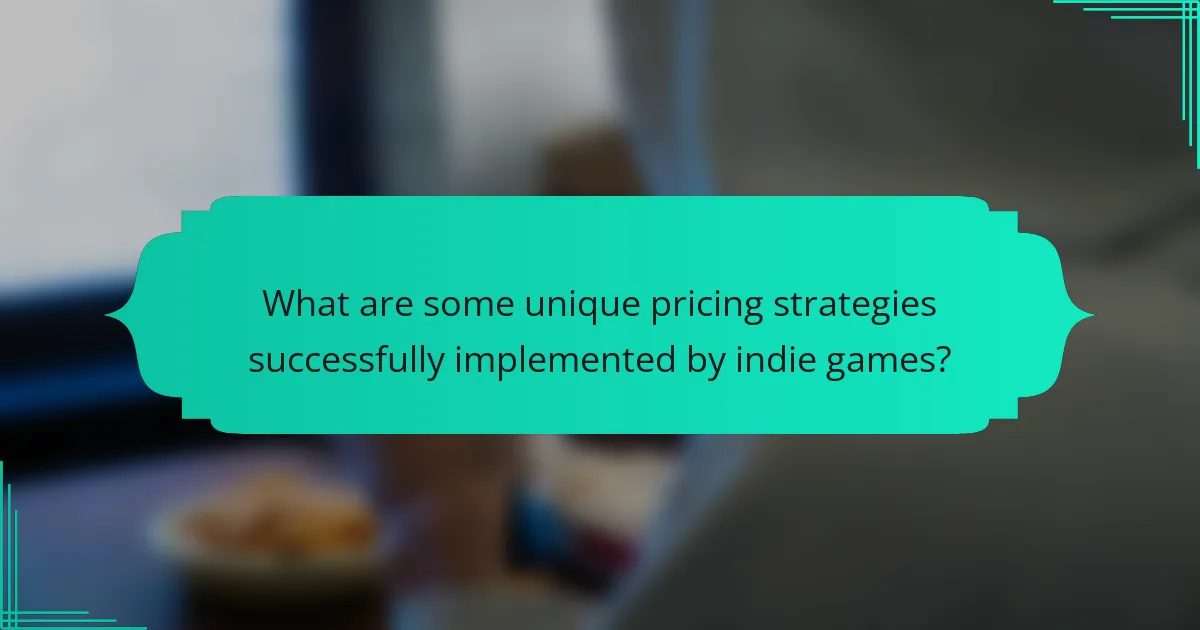
What are some unique pricing strategies successfully implemented by indie games?
Indie games have successfully implemented unique pricing strategies that enhance their market presence. One effective approach is the “pay-what-you-want” model, allowing players to choose their price, which can foster goodwill and increase sales. Another strategy is limited-time discounts, creating urgency and boosting visibility. Bundling games with other indie titles can enhance perceived value and attract more buyers. Additionally, offering a free demo can entice players to purchase the full version. Lastly, leveraging crowdfunding platforms not only raises funds but also establishes a committed player base, ensuring initial sales success.
How have indie games utilized pay-what-you-want models effectively?
Indie games have effectively utilized pay-what-you-want models by fostering community engagement and maximizing revenue. This pricing strategy allows players to contribute based on their perceived value of the game. Successful examples include titles like “Humble Bundle” and “Undertale,” which generated significant profits while building a loyal fan base. The unique attribute of this model is its flexibility, enabling developers to reach a wider audience and adapt to market demand. As a result, many indie developers have embraced this approach to enhance their visibility and support sustainable growth.
What role do limited-time offers and bundles play in indie game pricing?
Limited-time offers and bundles significantly enhance indie game pricing by creating urgency and perceived value. These strategies attract consumers, boost sales, and can help indie developers stand out in a crowded market.
Limited-time offers encourage quick purchasing decisions, leveraging psychological triggers like scarcity. Bundles provide a cost-effective way for players to access multiple games, increasing overall sales volume.
As a result, these pricing tactics can lead to higher revenue and greater visibility for indie games, especially during promotional events or seasonal sales. They can also foster a loyal customer base through perceived savings and exclusive content.
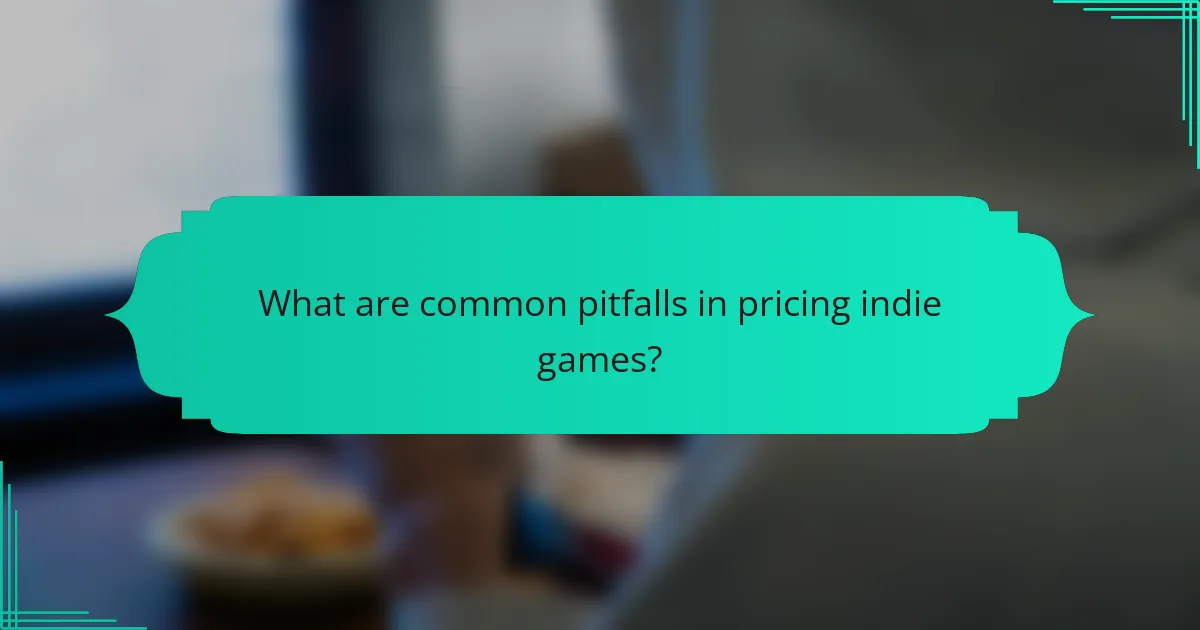
What are common pitfalls in pricing indie games?
Common pitfalls in pricing indie games include setting prices too high, underestimating production costs, and neglecting market research. Many developers overlook the importance of perceived value, leading to misalignment with consumer expectations. Additionally, failing to adjust prices post-launch can hinder sales. Understanding competitor pricing and audience willingness to pay is crucial for success.
What mistakes should indie developers avoid when setting prices?
Indie developers should avoid common pricing mistakes to maximize revenue and player engagement. First, neglecting market research can lead to mispriced games. Understanding competitor pricing and player expectations is crucial. Second, setting prices too high can alienate potential buyers, while pricing too low may undervalue the game. Third, ignoring the importance of discounts and promotions can limit sales opportunities. Lastly, failing to adapt prices based on feedback and sales performance can hinder long-term success.
How can overpricing or underpricing impact long-term success?
Overpricing can alienate potential players, while underpricing may undervalue the game and reduce revenue. Both strategies can hinder long-term success. Overpricing risks low sales volume and negative reviews, whereas underpricing can lead to unsustainable profit margins. Balancing price with perceived value is crucial for indie game developers.
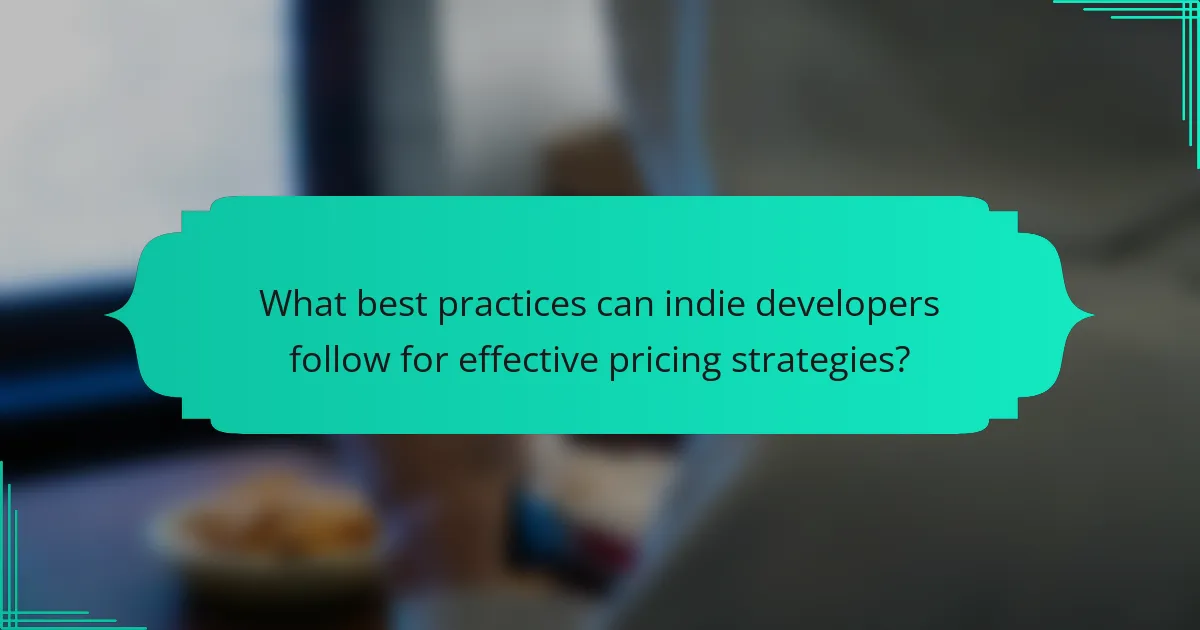
What best practices can indie developers follow for effective pricing strategies?
Indie developers can follow several best practices for effective pricing strategies. First, research comparable games to understand market pricing. Second, consider a tiered pricing model to appeal to different player segments. Third, utilize promotional pricing during launch to attract initial players. Fourth, gather player feedback to adjust prices based on perceived value. Lastly, analyze sales data regularly to refine pricing strategies over time.
How can indie developers leverage data analytics for pricing optimization?
Indie developers can effectively leverage data analytics for pricing optimization by analyzing player behavior and market trends. By utilizing tools that track user engagement, sales data, and competitor pricing, developers can identify optimal price points that maximize revenue while maintaining player interest. Implementing A/B testing can further refine pricing strategies based on real-time feedback and performance metrics. This data-driven approach enhances the ability to adapt to market fluctuations and consumer preferences, ultimately leading to improved sales performance.
What are expert tips for testing and adjusting pricing strategies over time?
To effectively test and adjust pricing strategies for indie games, regularly analyze player feedback and sales data. Monitor market trends and competitor pricing to remain competitive. Experiment with different pricing models, such as freemium or pay-what-you-want, to gauge player response. Implement A/B testing to compare pricing strategies and determine which yields the best results. Adjust pricing based on seasonal trends or game updates to maximize revenue potential.
